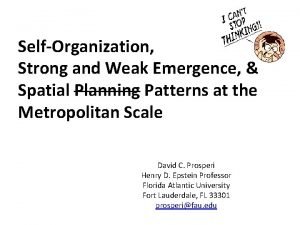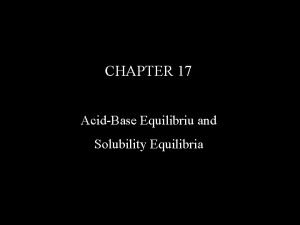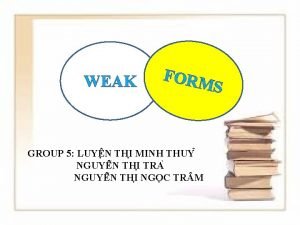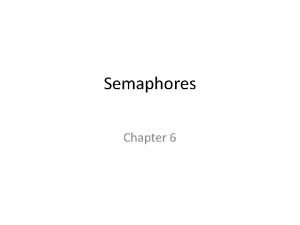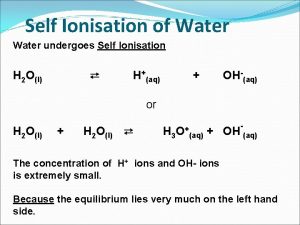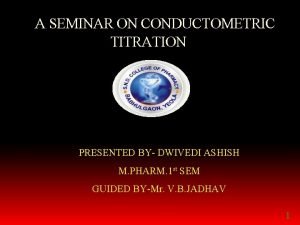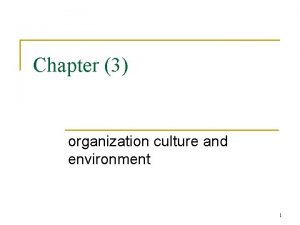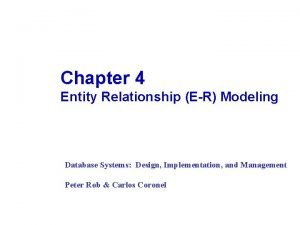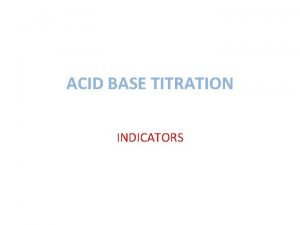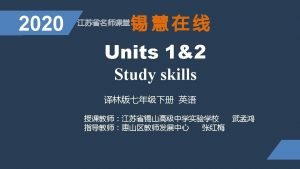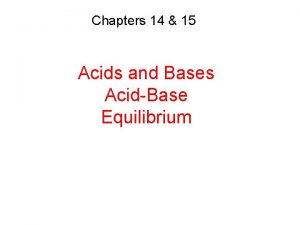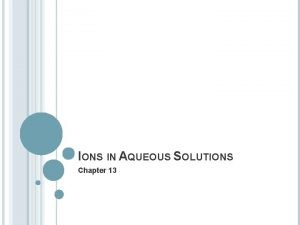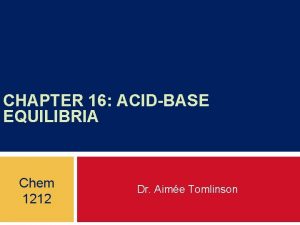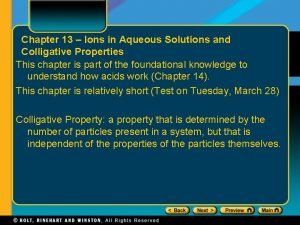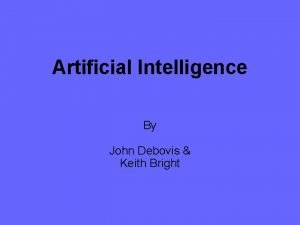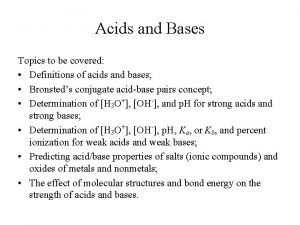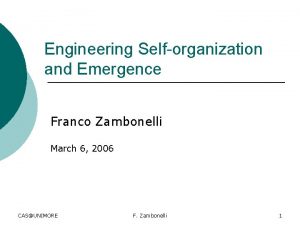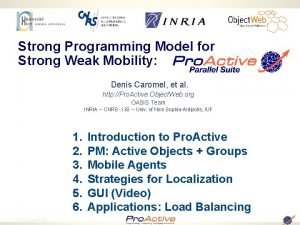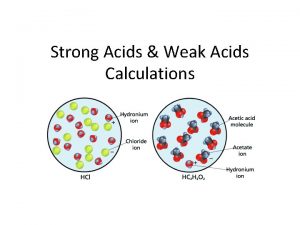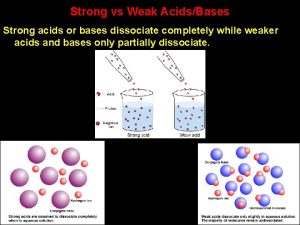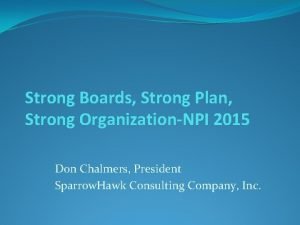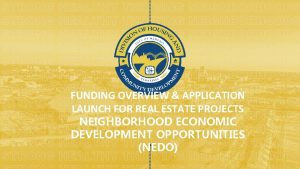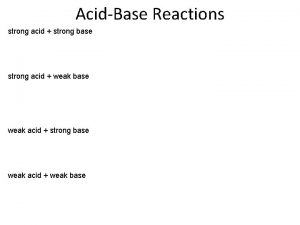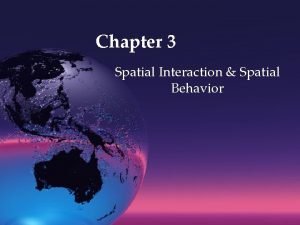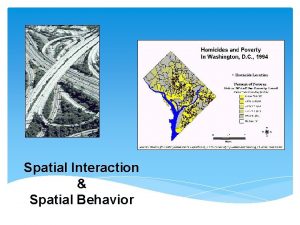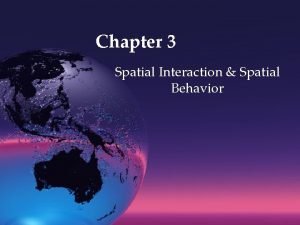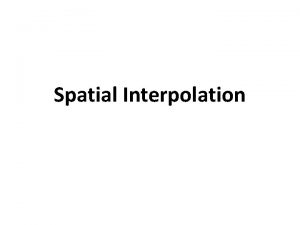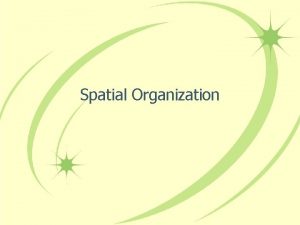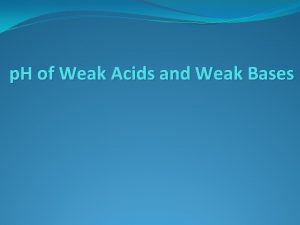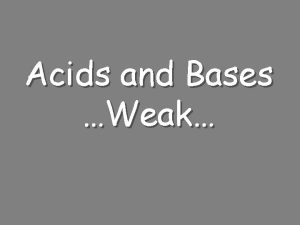SelfOrganization Strong and Weak Emergence Spatial Planning Patterns




































- Slides: 36

Self-Organization, Strong and Weak Emergence, & Spatial Planning Patterns at the Metropolitan Scale David C. Prosperi Henry D. Epstein Professor Florida Atlantic University Fort Lauderdale, FL 33301 prosperi@fau. edu

“the majority … were attracted less by theoretical and philosophical ideas enfolded in the TCS … but more by some of the methodologies associated with the study of complex systems” Portugali, 2006, p. 651 ‽ the need for a theoretical perspective 9/16/2020 Intro. . . Patterns. . . SO&E. . . Results. . . Conclusion

Introduction The Emergent Pattern I Focus On My 15 (Pondering) Minutes Separation Self-Organization & Emergence Employment Patterns in South Florida Conclusion & Discussion Weak Emergence Finding the Nexus References Strong Emergence

dcp’s Left-Sided Brain • The Object of Planning: To arrange, re-arrange or shape/advocate/modify elements of a system in such a way to enable macro-properties of urban regions to be at adequate levels • From URP 6840: Learning Agents Self-Organizing, through a Complex Adaptive System, realizing Emerging Patterns to reach the Edge of Chaos in an open, non-linear, disequilibrium environment, amplifying or dampening effects by examining feedback of biogeographic barriers 9/16/2020 Intro. . . Patterns. . . SO&E. . . Results. . . Conclusion

Some Typologies About Planning Grunau and • A Third Turn: Return to (from Reading, Portugali, Batty, de Roo & Silva) Content Schonwandt Webster De Roo Batty’s Website Portugali’s Complaint 9/16/2020 • Urban Science • Planning turns (object, sustantantive -> communicative process) • (50 years) • 4 Crises Intro. . . Patterns. . . SO&E. . . Results. . . Conclusion

It is the Frame That Matters (to me) • New Tropes (interaction & networks, emergence, adaptive innovation and criticalization) – Goldstein, Richardson, Allen & Snowden, E-CO Annual 2006 • Equilibrium is over rated as a complaint about previous frameworks • Emergence is About Scope, Not Scale (Ryan, 2006) • See Emergence as a Metaknowledge (David, Courdier >2007) • Self-Organized Similarity, the Evolution of Groups of Similar Species (Scheffer & van Nes, 2006) 9/16/2020 Intro. . . Patterns. . . SO&E. . . Results. . . Conclusion

Next What are Macro-properties Bogart 9/16/2020 Bourne Others (Krugman, Allen, Portugali, Batty, Prosperi, Marshall) Intro. . . Patterns. . . SO&E. . . Results. . . Conclusion My Focus • Employment Patterns

Of Metropolitan Regions • Something that is observable at the scale of the urban region – Hierarchy of Shopping Centers – Hierarchy of Employment Centers • 30 -40% of overall employment is in these centers – Hierarchy of Roads – Social Spatial Patterns – Transport Systems, including Airports • Some, but not all, follow Zipf’s Law • Clearly, a “resultant”, probably an “emergent pattern” 9/16/2020 Intro. . . Patterns. . . SO&E. . . Results. . . Conclusion

Bogart’s Table Criterion Benchmark Employment in Centers Employment is distributed over the metropolitan area; 30 to 40% of it is located in identifiable employment centers. Downtown remains the largest center, but its dominance is attenuating downwards Employment centers are relatively specialized and unique Commuting 25 minutes on average, 85% less than 45 minutes Distances have increased, but time has not (decentralized jobs) Density Average person lives in areas of 3, 000/sq mi / 4. 6 persons per acre Average person works in areas of 4, 000/sq mi / 6. 2 persons per acre 1/3 live with 5 miles of CBD, 40% of employment is within five miles of CBD Congestion Has increased; Typical commuter spends 47 hours/year “stuck” in traffic Plans for Buildings Sports, convention centers, designed to attract business travellers and tourists both from “within” and “outside” the metro area Universities At least one high quality university Segregation Quite segregated by race, but falling Quite segregated by income, and it persists 9/16/2020 Intro. . . Patterns. . . SO&E. . . Results. . . Conclusion

Almost There … • Krugman • Allen (part on intra-urban variation) • Bourne • Portugali • Batty (metaphors – schelling, networks, systems over time) • Marshall (evolutionary development) • But, the EMERGING winner (so far, according to me) is: - 9/16/2020 Intro. . . Patterns. . . SO&E. . . Results. . . Conclusion

Santa Fe Institute (Geoffrey West) • • Urban Science v. Urban Theory – only way to understand is to know deep structure, there is a set of a few very simple equations. These are the laws that automatically emerge whenever people “agglomerate”. So, by these rules, he can make precise predictions about the number of violent crimes and the surface area of roads in a city in Japan with 200, 000 people. Real purpose of cities, and the reason cities keep on growing, is their ability to creative massive economies of scale, just a big animals do (cities are like elephants) – – – • • • So, as the city doubles, it requires an increase in resources of only 85% Densely populated places require less energy; small green places require more When a city doubles in size, every measure of economic activity increases by approximately 15% per capita (i. e. , folks in bigger cities will do 15% more of everything) – this is the value of economic interactions Also true for social problems – 15% increase in violent crimes, traffic and AIDS. What this tells you is that you can’t get economic growth without a parallel growh in the spread of things you don’t want). Large not necessarily good, however. Many fast growing cities – done away with public places in favor of suburban areas – are characterized by below-average levels of income and innovation (as measured by the production of patents); The same sidewalks that lead to knowledge trading also lead to cockroaches SUPERLINEAR SCALING: increased output of people living in larger cities. Wobbles at lower levels, then becomes a steep slope emerges from positive feedback loop of urban life – a growing city makes every one is that city more productive, which encourages more to people to move to the city, and so on. Good reason why animals slow down with size. Requires energy. Current humans requires about 11000 watts. Not sustainable. Mumford: megalopolis is the last stage in the classic style of civilization. But, technology changes rules. Cliffhangers and creativity. Cycles are getting faster --about 15 years between big innovations. Not all agree: Suburban job growth folk: SUSPECT THAT THIS IS A DEFINITIONAL PROBLEM. 9/16/2020 Intro. . . Patterns. . . SO&E. . . Results. . . Conclusion

My Take … Things I Could Do • Write a Complexity History Emerged Properties More Than One Center • Focus on Particular Set of Multiscalar Interactions Rank Order of Centers • Explore in More Detail Complexity Theory Concepts 9/16/2020 Functional Specialization 40% of Employment in Centers Intro. . . Patterns. . . SO&E. . . Results. . . Conclusion

Next Complexity Concepts Emergence Self. Organization 9/16/2020 • Weak • Strong Complexity Economics Intro. . . Patterns. . . SO&E. . . Results. . . Conclusion

Complexity Theory Attributes • It is a system. There is a WHOLE • Open – urban regions subject to many forces, some internal (local), some external, • Non-Equilibrium – we accept that a perfect, efficient, anything cannot be achieved (due to both natural features (rivers) but also due to path dependency and other accidents of history (see Batty) • “Ruled” by self-organization, which MAY include features of emergence • Multiscalar dynamics in ecology, economics, and governmental systems 9/16/2020 Intro. . . Patterns. . . SO&E. . . Results. . . Conclusion

The Research Problem From Wikipedia • • Definition (Wikipedia): is a process of attraction and repulsion in which the internal organization of a system, normally an open system, increases in complexity without being guided by an outside source. Sometimes self-organization is conflated with that of the related concept of emergence. Properly defined, however, there may instances of self-organization without emergence and emergence without self-organization, and it is clear from the literature that the phenomena are not the same. The link between emergence remains an active research question. 9/16/2020 What? • Clear from the Literature? ? • Remains an Active Research Question Intro. . . Patterns. . . SO&E. . . Results. . . Conclusion

Approach Separate Find Nexus • Strong Emergence in Self-Organizing Systems • Not Very Well Treated in the Literature • Weak Emergence in Self-Organizing Systems • This is the “Normal” Way 9/16/2020 Intro. . . Patterns. . . SO&E. . . Results. . . Conclusion

• ? ? ? Looking for Examples Self. Organization with Emergence Self. Organization without Emergence Controlled Organization with Emergence • ? ? ? Looking for Examples 9/16/2020 • ? ? ? Looking for Examples Intro. . . Patterns. . . SO&E. . . Results. . . Conclusion

Some Readings on Emergence Name Year Title Fromm Ten Questions about Emergence Halley & Winkler Classification of Emergence and its relation to self-organization Batty 2003 The Emergence of Cities: Complexity and Urban Dynamics Bar-Yam A Mathematical Theory of Strong Emergence Using Multiscale Variety Fromm Types and Forms of Emergence Corning 2002 The Re-Emergence of “Emergence”: A Venerable Concept in Search of a Theory Bedau Weak Emergence Bedau Downward Causation and the Autonomy of Weak Emergence David & Courdier See Emergence as a Metaknowledge Ryan 2006 Emergence is Coupled to Scope, not Level Osberg, Biesta & Cilliers From Representation to Emergence: Complexity’s Challenge to the Epistemology of Schooling Osberg & Biesta Complexity, Knowledge and the Incalculable: Epistemological and Preagogical Implications of ‘Strong Emergence’ Scheffer & E. H. van NEss Self-organized similarity, the evolutionary emergence of groups of similar species Deguet, Demazeau & Magnin Elements About the Emergence Issue: A Survey of Emergence Definitions Dessales & Phan Emergence in Multi-Agent Systems: Cognitive Hierarchy, Detection, and Complexity Reduction. Part I: Methodological Issues Abbott Emergence Explained Abbott Emergence, Entities, Entropy and Binding Forces 9/16/2020 Source Intro. . . Patterns. . . SO&E. . . Results. . . Conclusion Complexity 7(6): 18 -30

Ten Questions (definitions 1 -3, requirements 4 -5, calculus 6 -9, limitations 10) • • • Can we Understand It? Can we Define a Comprehensive Taxonomy or Classification What are the Underlying Principles? How are They Related? Is Novelty or the Need for an Observer Among Them? What is the Relation between Emergence and Evolution? Are there any processes similar or related to “emergence” in evolution? Are there any necessary requirements for “emergence” like mobility, intelligence or suitable environments? Is emergence a typical property of MAS? Is “emergence” only possible with simple or stupid agents? Or is it also possible complex BDI agents? Can we Find a Kind of Calculus for Multi-Agent Systems? How Can a Globally Desired Structure or Functionality be Designed on the Basis of Interactions Between Many Simple Modules? Can we solve the micro-macro link problem? Can We Use it? Is “emergence” one reason why agents are not widely used or why agents could be a new successful “programming paradigm” Can we Control it? Even if “emergence” is not predictable, is it in some ways controllable? What are the limitations of emergence and self-organization? (size limit, place limit, complexity limit, combinatorial limit) 9/16/2020 Intro. . . Patterns. . . SO&E. . . Results. . . Conclusion

Common Characteristics • Radical Novelty (features not previously observed in systems) • Coherence or Correlation (meaning integrated wholes that maintain themselves over some period of time) • A Global or Macro “Level” (there is some property of wholeness) • Product of a Dynamical Process (it evolves) • Ostensive (it can be perceived) • Supervenience – downward causation 9/16/2020 Intro. . . Patterns. . . SO&E. . . Results. . . Conclusion

Emergent Properties & Processes • An emergent behavior or emergent property can appear when a number of simple entities (agents) operate in an environment, forming more complex behaviors as a collective. • If emergence happens over disparate size scales, then the reason is usually a causal relation across different scales (in other words, there is a form of top-down feedback in systems with emergent properties). • Etc. 9/16/2020 Intro. . . Patterns. . . SO&E. . . Results. . . Conclusion

Emergent Structures • Emergent structures are patterns not created by a single event or rule. Nothing commands the system to form a pattern. • The emergent structures are more than the sum of their parts because the emergent order will not arise is the various parts are simply co-existing; the interaction of these parts is central. 9/16/2020 Intro. . . Patterns. . . SO&E. . . Results. . . Conclusion

Three Forms of Emergent Structures • First-Order emergent structures occur as a result of shape interactions (e. g. , hydrogen bonds in water molecules lead to surface tension) • Second-Order emergent structures involve shape interactions played out sequentially over time (e. g. , changing atmospheric conditions as a snowflake falls to the ground build upon and alter its form) • Third-Order emergent structures are a consequence of shape, time, and heritable instructions (e. g. , an organism’s genetic code sets boundary conditions on the interaction of biological systems in space and time) 9/16/2020 Intro. . . Patterns. . . SO&E. . . Results. . . Conclusion

Weak and Strong Emergence Weak Emergence Strong Emergence • Describes new properties arising in systems as a result of interactions at an elemental level • But, if systems have qualities that are not directly traceable to the system’s components, but rather to how those components interact, and one is willing to accept that a system SUPERVENES on its components, then it if difficult to account for an emergent property’s cause. The new qualities are irreducible to its constituent parts. The whole is greater than the sum of its parts. This view is called strong emergence. • Weak: complex adaptive behavior – simple rules 9/16/2020 Intro. . . Patterns. . . SO&E. . . Results. . . Conclusion

Strong Emergence Rare Not Predictable in Principle New or Many Systems Boundary between Different Evolutionary Systems, “barrier of relevance” Gateway or Quantum Leap in Evolution to New (Evolutionary) System 9/16/2020 Intro. . . Patterns. . . SO&E. . . Results. . . Conclusion

Complexity v. Traditional Economics (Santa Fe Institute) Dynamic Agents Networks Emergence Evolution Technology Complexity Economics Open, dynamic, non-linear systems, far from equilibrium Modelled individually; use inductive rules of thumb to make decisions; have incomplete information; are subject to errors and biases; learn to adapt over time; heterogeneous agents Traditional Economics Closed, static, lienar systems in equilibrium Modelled collectively; use complex deductive calculations to make decisions; have complete information; make no errors and have no biases; have no need for learning or adaptation (are already perfect), mostly homogeneous agents Explicitly model bi-lateral interactions between Assume agents only interact indirectly through individual agents; networks of relationships change market mechanims (e. g. , auctions) over time. No distinction between micro/macro economics; Micro- and macroeconomics remain separate macro patterns are emergent result of micro level disciplines behavior and interactions The evolutionary process of differentiation, No mechanism for endogenously creating novelty, selection and amplification provide the system with or growth in order or complexity novelty and is responsible for its growth in order and complexity Technology fluid, endogenous to the system Technology as given or selected on economic basis Preferences Formulation of preferences becomes central; individuals not necessarily selfish Preferences given; Individuals selfish Origins Based on Biology (structure, pattern, selforganized, life cycle) Based on 19 th century Physics (equilibrium, stability, deterministic dynamics) Elements Patterns and Possibilities Price and Quantity 9/16/2020 Intro. . . Patterns. . . SO&E. . . Results. . . Conclusion

Next Results Some Pictures / Charts of Emerged Pattern 9/16/2020 Some Thoughts • From Weak Emergence • From Strong Emergence Intro. . . Patterns. . . SO&E. . . Results. . . Conclusion

Outline of Thought Process • The System is Territorially Closed, but Functionally Open • The Emergent Pattern is calculable and describable • The key is to discover the “agents” that selforganized or the processes that self-organized to RESULT in the emerged functional/spatial pattern. 9/16/2020 Intro. . . Patterns. . . SO&E. . . Results. . . Conclusion

9/16/2020 Intro. . . Patterns. . . SO&E. . . Results. . . Conclusion

40% Employment in Specialized Centers 9/16/2020 Intro. . . Patterns. . . SO&E. . . Results. . . Conclusion

A First Explanation Elements of Weak Emergence Elements of Strong Emergence • The Shopping Center Model • Global Business Districts – Places grew bigger and more complex • Places Change Their Functionality in terms of new pressures – Historic centers become functionally specialized 9/16/2020 – The need for a new kind of space for a new kind of business • Airport Related Development – Fifth wave of transport • Megaprojects? Planned Decentralization? Istanbul Examples. Intro. . . Patterns. . . SO&E. . . Results. . . Conclusion

Next Conclusions … Regarding Case Study Emergence Complexity 9/16/2020 Intro. . . Patterns. . . SO&E. . . Results. . . Conclusion

… regarding the case study • The pattern of centers has evolved (Marshall) over time due to: – Accident (which ones) – Purposeful Decentralization of Office Functions (particularly those involving IT) in the 1970 s – Positive Feedback: Purposeful Concentration of Functions (particularly in the shipping/importing & exporting) functions) in the 2000 s – Positive Feedback: Purposeful Concentration of Functions (advanced producer services, particularly banking) in the 1990 s – Positive Feedback: Purposeful Concentration of Functions (eds, meds, and govs) – If US had historic centers, they might also evolve as specialized tourist attractions 9/16/2020 Intro. . . Patterns. . . SO&E. . . Results. . . Conclusion

… regarding emergence • Still like it, • Particularly in nested hierarchies • Like the notion of slaving, strong attractors, some endogenous guidance • The really big planning idea is that endogenous guidance factors are not always the things that political systems or planners seek to guide or vice versa 9/16/2020 Intro. . . Patterns. . . SO&E. . . Results. . . Conclusion

… regarding complexity • The need to stay focused on substance – really like the word “entities” in the physics and philosophy literatures • Let’s work on differentiating the words “behavior” “pattern” “structure” etc • Less is More –there is a set of universal … West? !? !? ! 9/16/2020 Intro. . . Patterns. . . SO&E. . . Results. . . Conclusion

With all due respect to the planning theorists (Healey, Innes, et al. ) Tesekkür ederim, Danke, Gracias, Merci for your UNDIVIDED (non-complex) attention Less is more Emergence (complexity theory) as meta_knowledge Is strong emergence megaprojects and metropolitan region planning? 9/16/2020 More than Nested hierarchies We need Better Grammar 3 rd Turn: Return to Content Brain fried! Time for Coffee!
 So&e
So&e Ephesians 6:10-20 nkjv
Ephesians 6:10-20 nkjv Weak acid and weak base reaction
Weak acid and weak base reaction Strong base strong acid
Strong base strong acid Oflinemaps
Oflinemaps Weak forms in sentences examples
Weak forms in sentences examples Strong acid strong base titration
Strong acid strong base titration It is one strong syllable followed by a weak syllable
It is one strong syllable followed by a weak syllable Strong and weak semaphore
Strong and weak semaphore Ph 3 acid or base
Ph 3 acid or base 7 strong acuds
7 strong acuds Conductometric titration of weak acid and strong base
Conductometric titration of weak acid and strong base Displacement titration
Displacement titration Strong and weak organisational culture
Strong and weak organisational culture Weak and strong forms
Weak and strong forms Strong and weak relationship in er diagram
Strong and weak relationship in er diagram Weak acid and strong base titration curve
Weak acid and strong base titration curve Spondee example
Spondee example Stressed syllable expensive
Stressed syllable expensive Strong nucleophile and weak nucleophile examples
Strong nucleophile and weak nucleophile examples How to remember strong acids and strong bases
How to remember strong acids and strong bases Strong acid titration curve
Strong acid titration curve Acid base neutralization reaction
Acid base neutralization reaction H2so4 strong or weak
H2so4 strong or weak Strong ai vs weak ai
Strong ai vs weak ai Apa itu partial participation
Apa itu partial participation Amphiprotic vs amphoteric
Amphiprotic vs amphoteric Strong believer is better than weak
Strong believer is better than weak Strong vs weak electrolytes
Strong vs weak electrolytes Is h3po4 strong or weak
Is h3po4 strong or weak Strong ai vs weak ai
Strong ai vs weak ai Nh4cl strong or weak acid or base
Nh4cl strong or weak acid or base Strong vs weak electrolytes
Strong vs weak electrolytes Buffers and titrations
Buffers and titrations Strong ai vs weak ai
Strong ai vs weak ai Seven strong acids
Seven strong acids Nano3 acid or base
Nano3 acid or base
